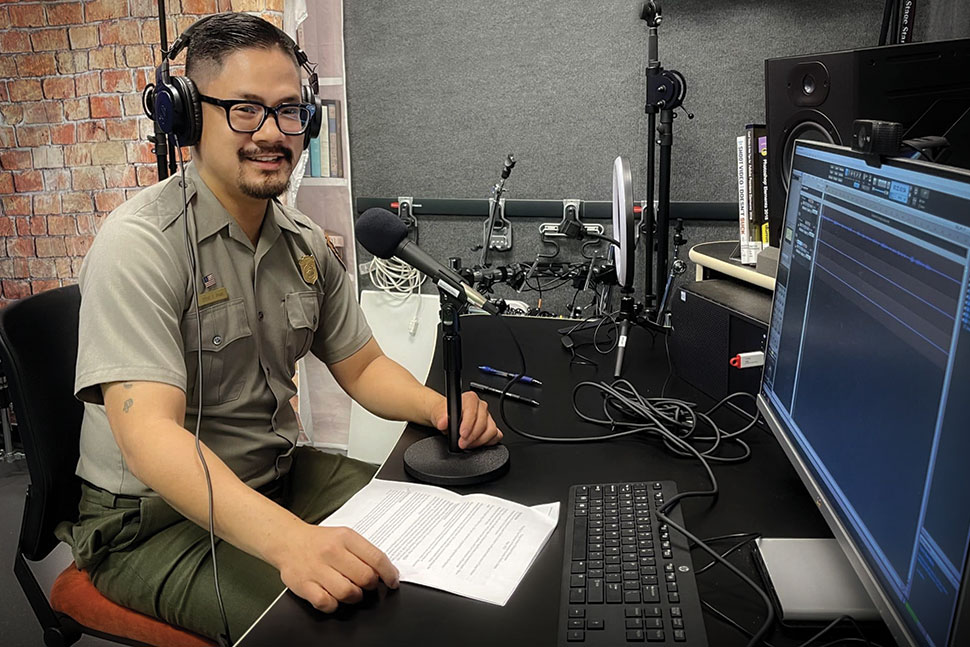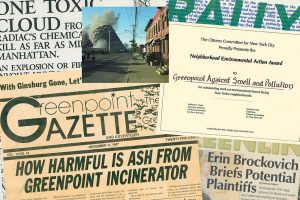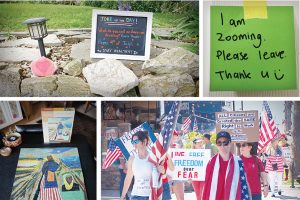
Steve Phan, a park ranger with the US National Park Service (NPS), remembers driving to his office in Washington, D.C., after the first shutdown of the COVID-19 pandemic occurred. “There was literally no one on the road,” he says. “It felt post-apocalyptic.”
Phan had volunteered for essential duties, including monitoring the parks that remained open, and had become busier than ever as people turned increasingly to outdoor activities. In January 2021, his work took him to central Kentucky, where NPS had recently acquired Camp Nelson, a former US Army base that was once a destination for many Black people fleeing slavery during the Civil War.
“We had to figure out how to build a new national park while maintaining social distancing, wearing masks inside, and not opening the visitor’s center,” Phan recalls. As COVID-19 dangers lingered, he eventually moved permanently to Kentucky, where he was interviewed about his atypical work experiences by Carrie Green, user education librarian at Jessamine County (Ky.) Public Library (JCPL). Phan’s account has become part of the library’s Pandemic Stories Project.
“[The pandemic] was a life-changing experience for everyone,” Phan told Green. “The residual impacts will affect us for generations.”
With the goal of preserving patrons’ COVID-19 experiences, JCPL was inspired to delve into oral history for the first time. Oral histories are typically captured by asking subjects questions to recount their memories while recording audio or video, which is usually transcribed before being archived. The subject may reflect on their own experiences, as well as their perceptions of historical events, cultural institutions, or the times in which they lived, depending on the focus of the project. Some librarians, like Green, conduct the oral history interviews themselves.
But with these projects come challenges with preservation and inclusion. Some institutions are revisiting old collections to undertake the significant and costly enterprise of updating them to modern formats, such as converting reel-to-reel tapes to digital files. Others are trying to approach their collections with cultural sensitivity and equity in mind, whether by collecting narratives from historically marginalized groups, soliciting reactions to social issues and political events, or addressing older material that may not have been obtained ethically.
Adding context to community

In 2021, Houston Public Library (HPL) received a $50,000 American Rescue Plan Act (ARPA) grant to digitize nearly 500 interviews. These interviews were collected by the Houston Oral History Project over several decades and reflect the voices of residents who are Black, Indigenous, and people of color. The histories, recorded from the 1970s to the present, are currently maintained by HPL’s Houston History Research Center (HHRC) and African American History Research Center (AAHRC). As they are digitized, they are added to HPL’s Digital Archives so that students, organizations, and other members of the public can access them.
Collection highlights include stories about a 1963 visit that President John F. Kennedy made to the city, Latino and Latina veterans of World War II, and alumni of the Gregory School, the city’s first public school for Black children, which opened in 1872. The Gregory School interviews, which feature students who graduated from the school between the 1920s and 1960s, are among AAHRC Manager Miguell Ceasar’s favorite, because the former school has become home to the center.
“They were thriving, and they were learning, and they were proud people,” says Ceasar. “It’s a great oral history to listen to, especially for our site.”
In their interviews, alumni also discussed what it was like growing up in and around Freedmen’s Town, a neighborhood settled in Houston’s Fourth Ward in 1865 by the first 1,000 formerly enslaved individuals from nearby plantations in Texas and Louisiana.
Today, Freedmen’s Town has largely been gentrified, Ceasar says, and many people moving in may not be aware of the area’s history. But digitizing these oral histories helps to provide valuable context for new residents. “[These stories are] a window into the past of what things used to be, that without other means, would probably go undocumented or unrecorded,” he says.
Oral traditions hold special meaning in the African American community, Caesar notes. Because it was illegal for enslaved people to read or write, they relied heavily on word of mouth to pass down history, meaning that “every story is significant,” he says.
HPL is also using a small portion of its ARPA funds to collect a new set of oral histories, called Memory Projects. These are focused on collecting recorded interviews from community members living through a cultural moment, as opposed to looking back on the past. Topics discussed include the COVID-19 pandemic and the June 2020 demonstrations that occurred in the wake of the killing of George Floyd at the hands of Minneapolis Police Department officers. Librarians and archivists from both HHRC and AAHRC are conducting these interviews.
“People who we interact with are surprised that we think what they have to say is important,” says Sheena Wilson, assistant manager and lead archivist at AAHRC. “We try to centralize that ‘everyday person’ so they’re able to see how what they’ve done fits into the larger historical narrative.”
Reclaiming the narrative

At University of New Mexico’s (UNM) Center for Southwest Research and Special Collections (CSRSC) in Albuquerque, Jolene Dezbah Manus, curator of Native American Collections, is digitizing oral histories that were collected from Indigenous communities across the US between 1966 and 1972 and are now housed at academic libraries.
UNM is among six other universities—along with the Association of Tribal Archives, Libraries, and Museums—participating in a $1.6 million digitization effort funded by the Doris Duke Foundation. CSRSC began working on this project in September 2021, and its collection contains nearly 800 interviews from members of approximately 50 tribes.
In addition to digitizing these oral histories, CSRSC is hoping to address harm caused by past interview processes. Many of the original oral histories were collected without informed consent from their subjects or by using insensitive or dehumanizing approaches, says Manus, who is Diné, Omaha, and Tsalagi (Cherokee), and part of the Navajo Nation. The interviews were conducted by academics—some of whom were Indigenous and others who were not—often with little training, especially on how to respect the culture of the participants, she says.
Part of the digitization project includes a thorough review process led by the tribes whose members gave their testimonies. This aims to ensure that tribes determine who may have access to a story, and under what circumstances. For example, tribal members may determine that some stories in the archive can be fully accessible to anyone who wishes to review them, while other stories may only be accessed by the tribe or only certain members of it. Tribal members can also decide if they want library workers present during the review or not, and whether oral histories should be held at the center or made available online.
“I have come to know that there are things in the [oral histories] that should not be accessible to everyone,” Manus says, “even for me, as a Diné woman. For that reason, I don’t listen to anything from any of the tribes that [are not my communities]—that’s not my purview.”
One of Manus’s roles in the project is to contact tribes and inform them that the project is under way. A unique case that she recalls is when members of the Cabazon Band of Cahuilla of California reached out to CSRSC after learning the institution held interviews pertaining to its history. She then sent copies for the tribe to review.
“[Cahuilla members] were really happy because the recordings contained people speaking their languages, and some aspects of the languages they hadn’t heard in a while,” Manus says. “At the same time, they were really cautious.”
The Cahuilla decided to make the documents accessible only to members of the tribe. “They were not in favor of the recordings becoming accessible because of past exploitation of their language,” Manus explains.
Limiting who can access an oral history is one of the key functions of Mukurtu, a content management system and digital access tool developed by researchers and the Warumungu, an Indigenous community in central Australia. The platform’s features can be adjusted to reflect the values of the Indigenous community it serves—for example, restricting collection access to subsets of a group or making certain materials available seasonally.
In using Mukurtu, CSRSC and its partners also hope to meet the project’s larger digitization goals. This involves converting oral histories from CDs and DVDs (which were initially collected in reel-to-reel, and then cassette formats) to digital formats, along with translating and indexing oral histories, improving access to them, expanding the collection by adding new voices, and developing educational resources.
The process is slow-moving, but CSRSC aims to have 150 histories digitized by the end of 2023. Manus says she hopes that having tribes lead the review process and set their own terms for others’ access helps them feel more empowered in the way their history is documented. The project’s success, Manus says, is “about starting a relationship, starting a talk, and having follow-ups after that to build trust.”
‘We can process together’
Oral history projects also allow librarians to capture the evolution of smaller communities or niche groups, so that members may see themselves and their peers documented for posterity.
What started as a small oral history project in the early 1990s grew into a larger effort to document the history of New York Public Library (NYPL) through the perspective of its former employees, members of the New York Public Library Retirees Association (NYPLRA). The project is spearheaded by the association, made up of current and former librarians who use their skills to collect, transcribe, and edit interviews.
The 118 stories recorded so far stitch together a history of NYPL while showing how the lives of its employees have intersected with larger world events, such as the Holocaust and civil rights movement. NYPLRA currently stores its collection on Dropbox but is seeking a permanent home at NYPL.
“Those of us who are working on the project are getting an enormous amount out of it,” says Beth Wladis, a retired NYPL librarian and NYPLRA member who volunteers her time editing transcripts. “We love the work.”
Wladis says she feels honored to help preserve the stories of NYPL retirees, which include memories of immigration, segregation, and economic insecurity—along with tales of connection, charity, and resilience.
“This is not a paying gig, but it’s very important in my life,” Wladis says. “It’s making my retirement so much more fascinating.”
For JCPL’s Pandemic Stories Project, Jessamine County resident Sheila Lovell shared her experience writing daily emails to her grandchildren, which often comprised stories from her life.
“It was very therapeutic for me to think and write one page every day,” Lovell said in her video interview. “I’m hoping [my grandchildren] got something out of it and that they learned a bit more about their grandmother—other than that she makes cookies.”
JCPL had an existing podcast studio convenient for recording stories by those willing to visit the library, as well as an online submission form that invited print, audio, and video contributions from others.
The library solicited submissions detailing any aspect of the pandemic experience: What were you doing when you first heard about COVID-19 and the shutdown? Did the pandemic change your relationships with family and friends? What have you learned during this experience?
“The whole idea was to get people talking and sharing and learning, and [realizing] we can process together, and we didn’t go through this alone,” says Les Lehman, community connections librarian at JCPL.
It was a challenge to get patrons to submit audio and video while the pandemic was still unfolding, Lehman says. The project also got sidelined by the debut of a popular outreach van, Jessamine Events Mobile, which was funded by the same ARPA grant. To keep the oral history project going, staffers created alternative opportunities, like a type-in event in June 2022 where patrons could document their pandemic experiences on typewriters set up at the library.
In total, the library collected 50 narratives across different mediums. Lehman thinks the contributions tended toward documenting the lighter side of life during the pandemic era.
“We got quite a few stories about funny things or things people learned,” she says. “A lot of people realized that they loved the time to explore something else in their life or connect with their immediate family [because of social distancing]. We didn’t necessarily touch their wounds.”
In September 2022, JCPL hosted a culminating exhibit where people could hear and view the collected stories and add to them. The library also shared part of the collection on social media.
Lehman encourages libraries interested in engaging with oral history to start gathering recordings using smartphones if they don’t have sophisticated equipment and to lean on staffers who would excel at interviewing. (See DIY Documenting below for more.)
“You should leverage the staff people who enjoy some investigative reporting, who want to get out there and really want to talk to people,” she says. “Tackle this project with a lot of joy and you’re going to learn a lot.”
DIY Documenting
At Oak Park (Ill.) Public Library (OPPL), patrons can check out oral history kits to pursue their own projects. The kits, which were created in 2019, include iPods, a microphone, headphones, and a laminated list of instructions and possible questions.
Apple discontinued iPods in 2022, but they’re still suitable for recording MP3 interviews. Oral History in the Digital Age, an online clearinghouse from the Institute of Museum and Library Services, and the nonprofit Vermont Folklife both have guides to resources for capturing oral history, including recommendations for recorders and microphones.
To create the questions, OPPL took inspiration from the national nonprofit StoryCorps—which collects diverse personal histories that are housed in the Library of Congress—and added community-specific prompts. Questions range from basic (How large was your family? What do you do for a living?) to more thought-provoking (What wisdom would you pass on to your grandchildren? Have you experienced any miracles? What’s your favorite Oak Park memory?).
OPPL created the kits using funds from a $12,000 grant awarded by Age Options, a local nonprofit that advocates for seniors and their caregivers. The library also obtained a subscription to the software BiblioBoard, which staff spent time learning before the project launched.
“We wanted to target it to older adults who had connections to Oak Park,” says Rose Barnes, health and senior services librarian at OPPL. “It’s really a nice way to get out in the community and talk to people. People just instantly open up.”
Any cardholder can check out the kits. However, the pandemic forced the library to shift focus from promoting the kits to other pressing needs. And while five kits were created originally, three have not been returned. One remains in circulation and another travels with the library’s book bike.
“That’s always the tricky thing when you circulate technology,” Barnes says.
OPPL has so far collected 17 oral histories, most of which Barnes collected herself and the rest of which were submitted by community members. They can be accessed through BiblioBoard via the library’s website.
“One of my main aspirations for the project is to capture intergenerational conversations with community members,” she says. “If libraries focus on that aspect, there is a lot of potential to build upon relationships and form deeper bonds.”


